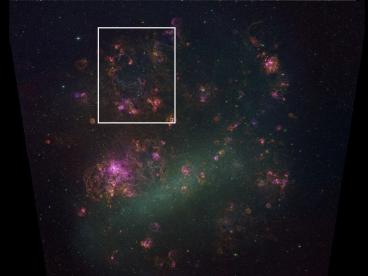Observations of ISM Bubbles - PowerPoint PPT Presentation
1 / 28
Title: Observations of ISM Bubbles
1
Observations of ISM Bubbles in the Galaxy and
Beyond You-Hua Chu University of Illinois
2
MCELS Smith, Points
Supergiant shells 1000 pc 107 yr (multi
generations) Superbubbles 100 pc 106 yr
(OB associations) Bubbles, SNRs 10 - 50 pc
103 105 yr (single star)
R - H? G - S II B - O III
500 pc
3
Interstellar Bubble Model Weaver et al. 1977
4
Interstellar Bubble Model Weaver et al. 1977
Igloo A Better Model Of Superbubble
5
Schematic Bubble Structure
Weaver et al. 1977
6
I. Hot Bubble Interior
X-ray emission from bubble interior
7
Hot Gas in the Orion Nebula
T 2 ? 106 K Lx 5.5 ? 1031 erg/s 3.5 pc in
diameter Güdel et al. 2008
8
Hot Gas in the Omega Superbubble
Two young superbubbles are detected in X-rays by
Chandra Omega and (Rosette) ROSAT -
Dunne et al. 2003, ApJ, 590, 306 Chandra -
Townsley et al. 2003, ApJ, 593, 874
9
LMC Superbubble N11
300 ks of Chandra ACIS-S observations
Red H? Blue X-ray
10
LMC Superbubble N11
Red H? Blue X-ray
11
LMC Superbubble N57
Red H? Green O III Blue X-ray
12
LMC Superbubble N70
Red H? Green O III Blue X-ray
13
LMC Superbubbles N44 and N51D
N51
N44
Chu et al. 1993, ApJ Cooper et al.
2004, ApJ
14
X-ray Observations of Bubbles
- Detection of hot gas associated with fast
winds - - 12 PNe, 2 WR bubbles, several
superbubbles - Properties of the hot gas
- Te 106 K Ne cm-3
LX erg/s - PN 1-3 ?106 100
1031 ? 1032 - WR 1-2 ?106 1
1033 ? 1034 - M17 7 ?106 0.3
1033 - Orion 2 ?106 0.2-0.5
5 ? 1031 - Eridanus
- LMC SBs
up to
1035
15
Nonthermal X-ray Emission
30 Dor C - Bamba et al. - Smith,
Wang RCW38 - Wolk et al. N51 - Cooper et
al. N11 - Maddox et al.
N51
Parizot et al. 2004 acceleration by repeated
shocks and turbulence
Synchrotron? Inverse Compton? ???
0.2 keV thermal power-law
16
I. Hot Bubble Interior
- X-ray emission from bubble interior is soft
- ISM absorbs soft X-ray emission
- X-ray emission depends on
- wind properties
- concentration of massive stars
- clumpy structure of the ambient medium
- magnetic fields
- supernova explosions
- - Nonthermal X-ray emission!!!
17
II. Dense Swept-up Shell
H? from H II shell, 21-cm from HI shell
18
HII and HI Shells of N11
100 pc
19
HII and HI Shells of N57
100 pc
20
HII and HI Shells of N51
100 pc
21
III. Conduction Layer
- Probe the thermal conduction layer
- High ions produced by thermal collisions
22
Probes of the Conduction Layer
C IV N V
O VI ll (Å) 1548, 1550 1238,
1242 1031, 1037 Obs. HST/STIS
HST/STIS FUSE I.P. (eV) 47.9
77.5 138.1 T
(K) 1.0?105 1.8?105
3.0?105 Teff (K) gt 35,000 gt
75,000 gt 125,000
Collisional ionization
Photo-ionization
23
OVI Absorption vs. Emission
NGC 7009
NGC 6543
Star
Inside
Outside
?1032
?1037
Observations by Iping et al.
Stellar P Cygni profile nebular O VI emission
24
FUSE Observations of NGC 6543
Gruendl et al. 2004
25
Circumstellar WR Bubble S 308
Boroson et al. (1997) detected N V absorption
from the conduction layer. HST STIS observation
of N V and C VI emission was scheduled, but STIS
died. FUSE observations of O VI were awarded,
and it died, too. Spitzer can observe Ne V, but
it is running out cryogen.
HD 50896
R H? G O III B X-ray
26
O VI Emission Detected in Superbubbles N185,
N186E Sankrit Dixon 2007
27
III. Conduction Layer
- Probe the thermal conduction layer with
- high ions produced by thermal collisions
- NGC 6543 given the boundary conditions
- of hot interior and warm shell, thermal
- conduction appears to be consistent, but
- does not explain the low X-ray luminosity.
- O VI emission studies avoid contamination
- from hot halo gas
- SPEAR - O VI emission from Eridanus
- (Kregenow et al. 2006)
28
Final Words
Multi-wavelength observations are needed to
study the physical structure of ISM
bubbles. ISM bubbles need to be studied in
conjunction with the history and distribution of
massive Star formation.































